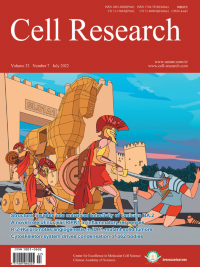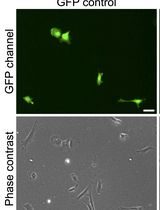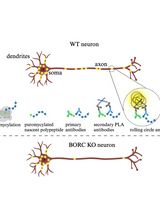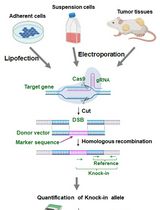- EN - English
- CN - 中文
In vitro Reconstitution of Phase-separated p62 Bodies on the Arp2/3-derived Actin Network
相分离的p62体在Arp2/3衍生的肌动蛋白网络上的体外重组
发布: 2023年04月20日第13卷第8期 DOI: 10.21769/BioProtoc.4656 浏览次数: 2186
评审: Oneil Girish BhalalaZhongmin LiuAnonymous reviewer(s)
Abstract
In cells, p62/SQSTM1 undergoes liquid–liquid phase separation (LLPS) with poly-ubiquitin chains to form p62 bodies that work as a hub for various cellular events, including selective autophagy. Cytoskeleton components such as Arp2/3-derived branched actin network and motor protein myosin 1D have been shown to actively participate in the formation of phase-separated p62 bodies. Here, we describe a detailed protocol on the purification of p62 and other proteins, the assembly of the branched actin network, and the reconstitution of p62 bodies along with cytoskeletal structures in vitro. This cell-free reconstitution of p62 bodies vividly mimics the phenomenon in which low concentrations of protein in vivo rely on cytoskeleton dynamics to increase the local concentration to reach the threshold for phase separation. This protocol provides an easily implemented and typical model system to study cytoskeleton-involved protein phase separation.
Keywords: p62 (p62)Background
Liquid–liquid phase separation (LLPS) plays critical roles in orchestrating biomolecular function and assembly of membrane-less organelles during diverse cellular processes (Banani et al., 2017). How LLPS is spatiotemporally regulated in the context of complicated cellular structures and components remains largely unknown. We recently revealed that cytoskeleton, as a solid phase, can actively participate in the phase separation of liquid-phase protein condensates, by using p62 bodies as a model system (Feng et al., 2022). P62/SQSTM1, a selective autophagy receptor, mediates LLPS of poly-ubiquitinated proteins into large condensates, which are also known as p62 bodies (Sun et al., 2018; Zaffagnini et al., 2018). The phase-separated p62 bodies can act as nucleation site for autophagosome formation, being then degraded by autophagy. Failure or inappropriate formation of p62 bodies is associated with pathological development of neurodegenerative diseases and Paget's disease, a chronic bone disease characterized by abnormal and excessive bone loss (Wong and Cuervo, 2010; Zaffagnini et al., 2018).
Despite p62 protein and polyubiquitin chain being shown to form large condensates in vitro (Sun et al., 2018), we reveal that the dendritic branched actin network is required for large p62 body formation in vivo. By establishing an in vitro reconstitution assay, we further demonstrate that such cytoskeleton components can greatly lower the protein concentration threshold during p62 body formation (Feng et al., 2022). The implication of cytoskeleton in LLPS represents an important and probably general way to achieve precise spatiotemporal regulation of biomolecular phase separation. Therefore, establishing an in vitro phase separation assay on cytoskeleton network is necessary and critical for these research fields; however, such protocol has not been clearly described before. Here, we present a detailed protocol to in vitro reconstitute p62 bodies along with branched actin network components in Lab Tek Chambered cover glasses. Actin polymerization is initiated by adding actin monomer, Arp2/3 complex, capping protein (CapZ), and PWCA [a domain consisting of a conserved C-terminal proline-rich region and WASP-homology 2 peptides plus a connector and acidic segments, which promotes Arp2/3-mediated actin polymerization (Campellone et al., 2008)]. Motor protein Myo1D is also added to facilitate phase separation of p62 and poly-ubiquitin (Ub8). The in vitro–reconstituted p62 bodies can be visualized by total internal reflection fluorescence (TIRF) and scanning electronic microscopy. This protocol provides an instruction on how to set up an in vitro phase separation assay involving cytoskeletal components.
Materials and Reagents
HEK293F cells (ATCC, catalog number: CRL-1573)
Sf9 cells (ATCC, catalog number: CRL-1711)
BL21 (DE3) E. coli cells (TransGen Biotech, catalog number: CD601-02)
Lab Tek Chambered cover glass (Thermo Fisher Scientific, catalog number: 150682)
SMM 293-TII expression medium (Sino Biological, catalog number: M293TII)
Sf-900 II SFM medium (Thermo Fisher Scientific, catalog number: 10902096)
Polyethyleneimines (PEI) (Polysciences, catalog number: 23966-2)
Amylose beads (New England Biolabs, catalog number: E8035S)
LB broth powder (Sangon Biotech, catalog number: A507002)
Isopropyl-beta-D-thiogalactopyranoside (IPTG) solution (Sangon Biotech, catalog number: B541007)
Tris (Sigma-Aldrich, catalog number: 77-86-1)
Phenylmethylsulfonyl fluoride (PMSF) (Sigma-Aldrich, catalog number: 329-98-6)
Acetic acid (Sangon Biotech, catalog number: A501931)
Ammonium acetate (Sangon Biotech, catalog number: A600032)
Phosphate buffered saline (PBS) (HyClone, catalog number:SH80255.01)
HEPES (Sigma-Aldrich, catalog number: 7365-45-9)
Imidazole (Sigma-Aldrich, catalog number: 288-32-4)
Glycerol (Sinopharm, catalog number: 56-81-5)
DTT (dithiothreitol) (Inaclo, catalog number: 0281)
Maltose (Sigma-Aldrich, catalog number: 69-79-4)
Rosetta (DE3) pLysS-competent E. coli cells (TIANGEN, catalog number: CB108-02)
Strep-Tactin resin (IBA Lifesciences, catalog number: 2-1201-002)
D-desthiobiotin (Sigma-Aldrich, catalog number: D1411)
HisPur(tm) Ni-NTA Resin (Thermo Fisher Scientific, catalog number: 88222)
MBP Trap HP column (GE Healthcare, catalog number: 28-9187-78)
TEV protease (Solarbio, catalog number: P2060)
Sodium chloride (NaCl) (Sangon Biotech, catalog number: A610476)
PIPES (Sangon Biotech, catalog number: A620434)
Potassium chloride (KCl) (Sangon Biotech, catalog number: A610440)
MgCl2 (Sangon Biotech, catalog number: B601193)
EGTA (MedChemExpress, catalog number: HY-D0861)
Ethylenediaminetetraacetic acid (EDTA) (MedChemExpress, catalog number: HY-Y0682)
Adenosine 5'-triphosphate (ATP) (MedChemExpress, catalog number: HY-B2176)
MOPS (MedChemExpress, catalog number: HY-D0859)
Triton X-100 (Solarbio, catalog number: T8200)
Protease inhibitor cocktails (MedChemExpress, catalog number: HY-K0012)
Glucose oxidase (Solarbio, catalog number: G8030)
Catalase (Solarbio, catalog number: C8070)
Bovine serum albumin (BSA) (Solarbio, catalog number: A8010)
Methyl cellulose (MedChemExpress, catalog number: HY-125861)
Sucrose (Solarbio, catalog number: S8271)
ATP-Mg (Sigma Aldrich, catalog number: A9187)
Buffer A (see Recipes)
Buffer B (see Recipes)
Buffer C (see Recipes)
Lysis buffer (see Recipes)
Basic buffer (see Recipes)
Loading buffer (see Recipes)
High-salt buffer (see Recipes)
Wash buffer (see Recipes)
TIRF buffer (see Recipes)
Elution buffer (see Recipes)
Storage buffer (see Recipes)
Equipment
Nickel column (Bio-Rad, catalog number: 12009287)
Mono Q 5/50 GL column (GE Healthcare, catalog number: 17-5166-01)
HiTrap Q HP (GE Healthcare, catalog number: 17-1154-01)
Superdex200 Increase 10/300 GL (GE Healthcare, catalog number: 28990944)
Ultrafiltration discs (Sigma-Aldrich, catalog number: PLGC07610)
Allegra X-14 centrifuge, type 45 Ti rotor manual, JS-4.750 swinging-bucket rotor and buckets, 4 × 50 mL, 9 × 15 mL adapters (Beckman Coulter, model: Allegra X14, catalog number: A99464)
Water bath at 37 °C (Thermo Fisher Scientific, model: TSCIP19)
Incubator at 37 °C with 5% CO2 (Thermo Fisher Scientific, model: HERAcell 150i)
Confocal fluorescence microscopy (NIKON, A1 HD25)
Nikon SIM/STORM (TIRF)
Field emission scanning electron microscopy (FE-SEM) (FEI Quanta 200)
Critical Point Dryer (Shianjia Biotechnology, model: SCD-350M)
Software
NIS-Elements software (Laboratory Imaging)
ImageJ
Procedure
文章信息
版权信息
© 2023 The Author(s); This is an open access article under the CC BY-NC license (https://creativecommons.org/licenses/by-nc/4.0/).
如何引用
Liu, T., Xu, M. and Mi, N. (2023). In vitro Reconstitution of Phase-separated p62 Bodies on the Arp2/3-derived Actin Network. Bio-protocol 13(8): e4656. DOI: 10.21769/BioProtoc.4656.
分类
生物物理学 > 显微技术
生物物理学 >
生物化学 > 蛋白质 > 自组装
您对这篇实验方法有问题吗?
在此处发布您的问题,我们将邀请本文作者来回答。同时,我们会将您的问题发布到Bio-protocol Exchange,以便寻求社区成员的帮助。
Share
Bluesky
X
Copy link












